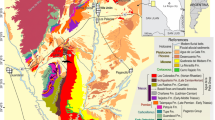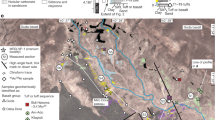Abstract
Faupl et al. question our confidence in the geochemical correlation that anchors the younger age constraint of 154 kyr on the Herto antiquities1. According to convention, we reported the tephrochemical correlation as the most probable explanation for the available data. Contrary to published information2,3, Faupl et al. contend that Quaternary volcanic centres in the Main Ethiopian Rift and the Afar depression are of “similar silicic composition”. They provide no datum and no specific counterargument to our correlation. Moreover, the single citation4 on which they base their assertion that our correlation is “highly speculative” contains no geochemical data.
Similar content being viewed by others
Clark et al. reply
The following facts bear on the contested correlation: the WAVT lies stratigraphically above a 160-kyr datum, whereas the Konso tuff is the first volcanic horizon stratigraphically below a 154-kyr datum; the WAVT and the Konso tuff are both fine vitric ashes with sparse, fragmented crystals of quartz and predominantly accidental feldspar derived from older crustal reservoirs (as shown by Ar–Ar geochronology), and homogeneous, bubble-wall and pumiceous glass shards. Analysis of individual glass shards from the WAVT and the Konso tuff yielded chemically homogenous single glass populations with a coefficient of similarity5,6 of 0.95; comparison of WAVT and the Konso tuff to regional tephra from major silicic volcanoes (6 Myr to Recent) in the Main Ethiopian and Afar Rifts, including the Middle Awash (n > 300 samples) and Konso (n = 39), yielded no correlation.
Furthermore, analysis of purified glass separates from the WAVT and the Konso tuff yielded data on major-element oxides and trace elements that confirm this correlation. Combined bulk glass major- and trace element data yielded a coefficient of similarity of 0.93. Our unpublished analysis of nine rare-earth elements (La, Ce, Nd, Sm, Gd, Dy, Er, Yb and Lu) in the same bulk glass separates yields a coefficient of similarity of 0.97, which further substantiates the published correlation1.
Figure 1 illustrates the relative stratigraphic position of the Konso tuff (TA-55) with respect to other identified Pleistocene tephra. Tephra positioned stratigraphically above and below the Konso Tuff, including the 154-kyr Konso Silver Tuff, contain heterogeneous and/or multimodal glass populations. This contrasts with the homogeneous, unimodal glass population observed in the Konso tuff and the correlative Upper Herto WAVT (MA92-1). Moreover, none of the individual glass populations in these other Pleistocene tephra yields chemical characteristics that are as similar to either TA-55 or MA92-1, as observed between these two tephra (Fig. 1).
Tephra are placed in relative stratigraphic context on the basis of field observations in the Konso region. Major elements are recalculated to 100% anhydrous and are plotted as percentage by weight of oxide on the x-axes. Symbols are average analyses of other Konso tephra layers; the same symbols are used to show the glass populations from a given tephra layer.
The eruption that produced the WAVT, which is more than 2 m thick and is preserved in the Upper Herto Member (MA92-1) and in the Konso region (TA-55), was comparable in volume to large eruptions that produced other ash-fall deposits that have been tephrostratigraphically and tephrochronologically correlated between sites in the Middle Awash, the Turkana Basin and the Gulf of Aden7,8. Although the identification of the specific volcanic sources of these large eruptions would be desirable, it is not a prerequisite for tephrochemical correlation.
Field observations in the Konso region place the TA-55 marker horizon stratigraphically below the Konso Silver Tuff dated at 154 kyr. This, as well as the identification of this marker horizon stratigraphically above the 160-kyr fossil-bearing sands of the Upper Herto Member of the Bouri Formation, Middle Awash, Ethiopia, provides convincing evidence that the Upper Herto archaeological and palaeontological remains, including the newly identified Homo sapiens idaltu, are securely constrained to be between 160 ± 2 and 154 ± 7 kyr old, as we stated1.
References
Clark, J. D. et al. Nature 423, 747–752 (2003).
WoldeGabriel, G. et al. Acta Vulcanologica 11, 53–67 (1999).
WoldeGabriel, G. et al. Quat. Internat. 13/14, 69–76 (1992).
Chernet, T. et al. J. Volcanol. Geotherm. Res. 80, 267–280 (1998).
Borchardt, G. A., Aruscavage, P. J. & Millard, H. T. Jr J. Sed. Pet. 42, 301–306 (1972).
Sarna-Wojcicki, A. M. in Quaternary Geochronology: Methods and Applications (eds Noller, J. S., Sowers, J. M. & Lettis, W. R.) 357–377 (AGU Ref. Shelf 4, Washington, DC, 2000).
Brown, F. H. Nature 300, 631–633 (1982).
Brown, F. H. et al. Quat. Internat. 13/14, 55–67 (1992).
Author information
Authors and Affiliations
Corresponding author
Rights and permissions
About this article
Cite this article
Hart, W., WoldeGabriel, G., Katoh, S. et al. Dating of the Herto hominin fossils. Nature 426, 622 (2003). https://doi.org/10.1038/426622a
Issue Date:
DOI: https://doi.org/10.1038/426622a
This article is cited by
-
Age of the oldest known Homo sapiens from eastern Africa
Nature (2022)
Comments
By submitting a comment you agree to abide by our Terms and Community Guidelines. If you find something abusive or that does not comply with our terms or guidelines please flag it as inappropriate.




